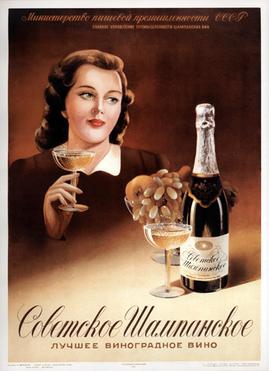Sovetskoye Shampanskoye
Sovetskoye Shampanskoye (Russian: Советское шампанское, "Soviet Champagne") is a generic brand of sparkling wine produced in the Soviet Union and successor states. It was a staple of Soviet and post-Soviet celebratory occasions and remains popular in the Russian Federation and other post-Soviet countries. The term "Sovetskoye Shampanskoye" is a notable example of a Soviet product that has outlived the Soviet Union itself, adapting to the changes in the market and consumer preferences over the decades.
History[edit | edit source]
The production of Sovetskoye Shampanskoye was initiated by a 1936 decree from Joseph Stalin, aiming to make sparkling wine accessible to the average Soviet citizen for celebrations. The method used for its production was developed by the Frenchman Eugene Charmat, which is quicker and more cost-effective than the traditional Champagne method. This method involves secondary fermentation in large tanks rather than in individual bottles, significantly reducing production costs.
During the Soviet era, Sovetskoye Shampanskoye was produced in various locations across the country, including notable facilities in Crimea and the Caucasus region. After the dissolution of the Soviet Union, the brand and production facilities were privatized, and the term "Sovetskoye Shampanskoye" became a point of legal contention. Despite this, the brand has continued to be used widely across the former Soviet states, albeit with variations in quality and production methods.
Production and Varieties[edit | edit source]
Sovetskoye Shampanskoye is typically made from a blend of several grape varieties, including traditional Champagne grapes such as Chardonnay and Pinot noir, as well as varieties more common in the Soviet Union, like Aligoté and Muscat. The wine is available in several sweetness levels, from dry (brut) to very sweet (dulce).
The quality and taste of Sovetskoye Shampanskoye can vary significantly depending on the producer and the production method. While some producers have modernized their facilities and adopted more sophisticated production techniques, others have maintained the mass-production methods of the Soviet era.
Cultural Significance[edit | edit source]
Sovetskoye Shampanskoye holds a special place in the cultural and social history of the Soviet Union and its successor states. It was, and in many places still is, an indispensable part of celebrations, particularly New Year's Eve, weddings, and other festive occasions. Its affordability and widespread availability made it a symbol of Soviet attempts to bring luxury and celebration into the lives of the working class.
Legal Issues and Market Presence[edit | edit source]
The name "Sovetskoye Shampanskoye" is not protected by geographical indication laws, leading to a proliferation of products with the same or similar names, varying widely in quality. In Russia, efforts have been made to regulate the use of the name, but with limited success due to the generic nature of the term and its deep-rooted presence in the market.
See Also[edit | edit source]
Search WikiMD
Ad.Tired of being Overweight? Try W8MD's physician weight loss program.
Semaglutide (Ozempic / Wegovy and Tirzepatide (Mounjaro / Zepbound) available.
Advertise on WikiMD
|
WikiMD's Wellness Encyclopedia |
| Let Food Be Thy Medicine Medicine Thy Food - Hippocrates |
Translate this page: - East Asian
中文,
日本,
한국어,
South Asian
हिन्दी,
தமிழ்,
తెలుగు,
Urdu,
ಕನ್ನಡ,
Southeast Asian
Indonesian,
Vietnamese,
Thai,
မြန်မာဘာသာ,
বাংলা
European
español,
Deutsch,
français,
Greek,
português do Brasil,
polski,
română,
русский,
Nederlands,
norsk,
svenska,
suomi,
Italian
Middle Eastern & African
عربى,
Turkish,
Persian,
Hebrew,
Afrikaans,
isiZulu,
Kiswahili,
Other
Bulgarian,
Hungarian,
Czech,
Swedish,
മലയാളം,
मराठी,
ਪੰਜਾਬੀ,
ગુજરાતી,
Portuguese,
Ukrainian
Medical Disclaimer: WikiMD is not a substitute for professional medical advice. The information on WikiMD is provided as an information resource only, may be incorrect, outdated or misleading, and is not to be used or relied on for any diagnostic or treatment purposes. Please consult your health care provider before making any healthcare decisions or for guidance about a specific medical condition. WikiMD expressly disclaims responsibility, and shall have no liability, for any damages, loss, injury, or liability whatsoever suffered as a result of your reliance on the information contained in this site. By visiting this site you agree to the foregoing terms and conditions, which may from time to time be changed or supplemented by WikiMD. If you do not agree to the foregoing terms and conditions, you should not enter or use this site. See full disclaimer.
Credits:Most images are courtesy of Wikimedia commons, and templates, categories Wikipedia, licensed under CC BY SA or similar.
Contributors: Prab R. Tumpati, MD

